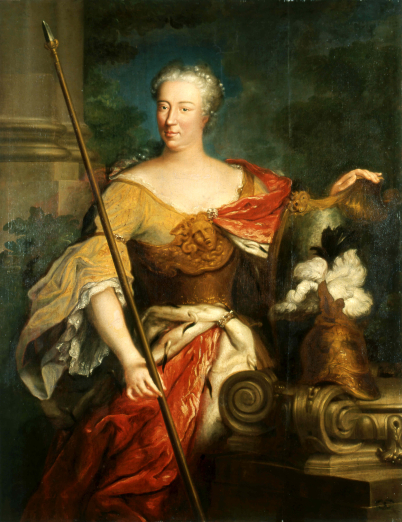
Elżbieta Sieniawska née Lubomirska (1669-1729), wife of the great hetman of the Crown. The only daughter of Stanisław Herakliusz Lubomirski, educated at the Visitant Girls’ School in Warsaw, from about 1680 at the court of Queen Maria Kazimiera. After marrying Adam Mikołaj Sieniawski she preferred to reside in Warsaw, and was frequently seen at court amidst the trusted confidantes of the queen. Her celebrated affair with Jan Stanisław Jabłonowski, the son of the great hetman of the Crown, produced a crisis in her marriage and although she made peace with her husband, Elżbieta soon became involved in a relationship with Prince Aleksander Sobieski.
After the death of Jan III, Elżbieta supported the candidature of Prince François of Conti, but quickly realised the weakness of his party and established contact with Augustus II. Following the departure to Rome of Maria Kazimiera, she administered the queen’s estates. In 1701-1703, urged by French diplomats, became engaged in supporting the anti-Habsburg uprising in Hungary and fell passionately in love with Ferenc Rákóczy, the leader of the insurgents.
After Augustus II resigned from the throne in 1706, Elżbieta Sieniawska joined the negotiations aiming at the achievement, with the assistance of French diplomacy, of an agreement between Tsar Peter I and Charles XII of Sweden. At the talks held by Peter I and envoy Stanisław Leszczyński she met her former lover Jabłonowski. When in November 1707 the Swedes abducted her from Warsaw, she spoke to Leszczyński. A month later, set free thanks to French mediation. In the spring of 1709 Sieniawska seriously considered placing on the throne Prince Konstanty, who visited her in Lwów. Although she protested against the return of Augustus II as king, she adapted herself to the new situation. In 1711, the godparents at the christening of Zofia, Sieniawska’s already 12 years-old daughter, included Peter I, Augustus II and Rákóczy. In the following years, Elżbieta was more a careful observer of the political scene than an active participant of the events. On her vast estates she conducted lively economic undertakings and traded in the produce of her land. Devoted much attention to her numerous residences (i.a. Puławy, Łubnice). Purchased Olesko and Tarnopol from Prince Konstanty, and in 1720 also Wilanów, where she built the side wings of the palace and an orangery. Employed outstanding artists, enabling the neglected royal residence to regain its brilliance and become a site commemorating Jan III, the victor of Vienna.
We would like to inform that for the purpose of optimisation of content available on our website and its customisation according to your needs, we use information stored by means of cookies on the Users' end devices. You can control cookies by means of your Internet browser settings. Further use of our website without change of the browser settings means that you accept the use of cookies. For more information on cookies used by us and to feel comfortable about this subject, please familiarise yourselves with our Privacy Policy.
✓ I understand